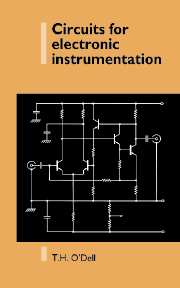Book contents
- Frontmatter
- Contents
- Preface
- 1 Circuits for electronic instrumentation
- 2 Sampling pulse generator circuits
- 3 Sample and hold circuits
- 4 Comparator circuits
- 5 Probes and input circuits
- 6 Wide-band amplifier circuits
- 7 Waveform generator circuits
- 8 Switched capacitor circuits
- 9 Phase locked loop circuits
- 10 Low noise circuits
- Name index
- Subject index
10 - Low noise circuits
Published online by Cambridge University Press: 05 June 2012
- Frontmatter
- Contents
- Preface
- 1 Circuits for electronic instrumentation
- 2 Sampling pulse generator circuits
- 3 Sample and hold circuits
- 4 Comparator circuits
- 5 Probes and input circuits
- 6 Wide-band amplifier circuits
- 7 Waveform generator circuits
- 8 Switched capacitor circuits
- 9 Phase locked loop circuits
- 10 Low noise circuits
- Name index
- Subject index
Summary
Introduction
As Wilmshurst [1] has written, noise in electronics has, today, come to mean ‘almost any kind of unwanted signal in an electronic system’. This is in contrast to the classical picture of noise as being a problem area which is only concerned with the fact that electronic circuits operate at a finite temperature and also have to operate with electric currents that are really made up of a flow of discrete charged particles. Further evidence for the wider view which is now taken of noise problems in electronics can be taken from the use of the term ‘electromagnetic compatibility (EMC) [2]’.
For the above reason, this chapter is really in two parts. To begin with, circuit shapes and circuit ideas that attempt to minimise the effects of the intrinsic thermal and shot noise of electronic devices will be considered. This calls for a brief summary of some well-known theory which will be given first. The topic then divides fairly naturally into low and high frequency amplifiers, and some interesting experimental circuits can be proposed for both fields. After this look at these classical kinds of noise problems, the chapter concludes by considering some of the circuit ideas which have been proposed to eliminate very special noise problems in various signal processing systems.
Intrinsic thermal noise sources
An excellent reference for the fundamentals of noise in electronic circuit design is chapter 11 of the book by Gray and Meyer [3].
Information
- Type
- Chapter
- Information
- Circuits for Electronic Instrumentation , pp. 187 - 212Publisher: Cambridge University PressPrint publication year: 1991
